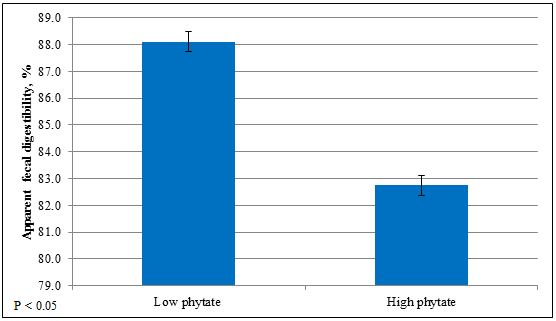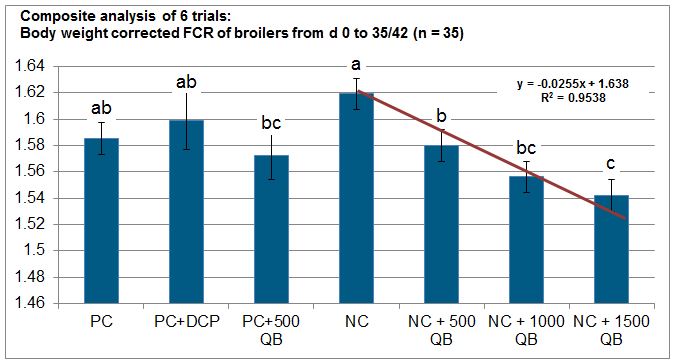



Superdosing to Eliminate Dietary Phytate an Opportunity for Performance Gains in Swine
The use of phytase feed enzymes is increasingly moving beyond the simple release of phosphorus (P), with more complete phytate elimination through superdosing offering considerable performance gains, according to AB Vista.It is a concept defined at the first International Phytase Summit in 2010 as the addition of sufficient phytase to quickly destroy all phytate present in the diet. This is now well-proven in delivering improved nutrient utilisation, reduced formulation costs and increased performance for both poultry and swine.
The impact of phytase as an anti-nutrient can be considerable. In binding to essential nutrients within the intestine, phytate not only renders them considerably less available to endogenous digestive enzymes, but also forces additional digestive secretions in an effort to compensate. It is a reaction that is both nutrient-inefficient and potentially damaging to the delicate gut wall lining.
Anti-nutrient Effects
Phytate has been implicated in reduced calcium, zinc, magnesium, sodium and copper digestibility, whilst also lowering the digestibility of amino acids by three to 16 per cent, depending on the amino acid and the makeup of the diet. The energy cost of additional secretions and losses in the gastrointestinal tract has been shown to reduce apparent energy metabolism in pigs, for example, by around eight per cent (see Figure 1).

(Source: Liao et al., 2005)
However, perhaps the clearest indicator of the benefits of eliminating phytate comes from the impact of superdosing using phytase enzymes. Phytases have long been used to release the P found in plant phytate and previously viewed as ‘non-available’, with common recommendations suggesting a 500FTU per kg feed dose of a modern phytase can release 0.10 to 0.15 per cent available P (avP). It is a level which is sufficient to provide worthwhile cost savings during feed manufacture.
Superdosing Benefits
Superdosing, in contrast, requires the use of phytase at over 1,000FTU per kg feed in an attempt to completely degrade all soluble phytate in the diet, effectively eliminating its anti-nutrient effects. The benefits are typically referred to as ‘extra-phosphoric’ (i.e. beyond simple P release), and result from increased feed intake, improved nutrient digestibility, additional mineral release, and reduced energy costs of digestion.
The results in Figure 2 show the clear impact of superdosing with Quantum Blue phytase on bodyweight-corrected feed efficiency in six trials with 35- to 42-day-old broilers, with a linear improvement (R=0.95, P<0.01) from a low-P negative control (NC) as the phytase dosage was increased in 500FTU per kg feed increments. The net result was a maximum improvement in feed efficiency of more than five points.

(composite analysis of six trials)
That these benefits come from the extra-phosphoric effects of superdosing was confirmed by adding extra P (in the form of dicalcium phosphate, +DCP) to a normal-P positive control (PC). There was no improvement in performance, i.e. the improvements seen during superdosing with Quantum Blue were not related to additional avP supply.
Phytate Elimination
The key to success is to achieve rapid and efficient phytate degradation at an early stage in the gastrointestinal tract, thereby maximising the time available for digestion and absorption processes to benefit.
It is also important to maintain continued phytate degradation even at low concentrations to drive towards elimination, rather than enzyme activity slowing down or stopping as soluble phytate levels drop. This would reduce levels, but not achieve the full benefits of elimination.
For example, at the standard level of dosing to release 0.10 to 0.13 per cent avP, just 50 to 60 per cent of the P locked up in dietary phytate needs to be released, whilst even the higher dose rates used to release perhaps 0.15 to 0.17 per cent avP only require up to 70 to 75 per cent phytate degradation.
In comparison, for the negative anti-nutrient effects of phytate to be eliminated, available (soluble) stomach phytate concentrations must be reduced to as low as 0.05 per cent or below, equivalent to 80 to 85 per cent total phytate degradation (the remaining insoluble phytate does not act as an anti-nutrient).
Product Differences
Optimal phytase characteristics for phytate elimination therefore differ from those required to simply release avP.
The ideal phytase for superdosing:
- is intrinsically thermostable (to avoid delays to onset of activity caused by thermostabilising coatings)
- is resistant to degradation by stomach proteases
- exhibits high levels of activity at the low pH found in the stomach and
- remains active at very low phytate concentrations (a low enzyme Km).
The challenge for commercial poultry and swine producers is that many of the phytase products currently on the market simply cannot meet these criteria. Further, activity at pH 5.5 (as used in the standard phytase assay method) does not relate to activity at the acidic pH found in the stomach.
In contrast, the third generation enhanced E. coli phytase Quantum Blue was designed specifically to meet the key requirements for superdosing, and is revolutionising the industry as a result.
With the potential additional value available from phytate elimination estimated to be as high as €5 per tonne of feed manufactured, the interest and uptake of superdosing will undoubtedly continue to grow strongly.
February 2015








